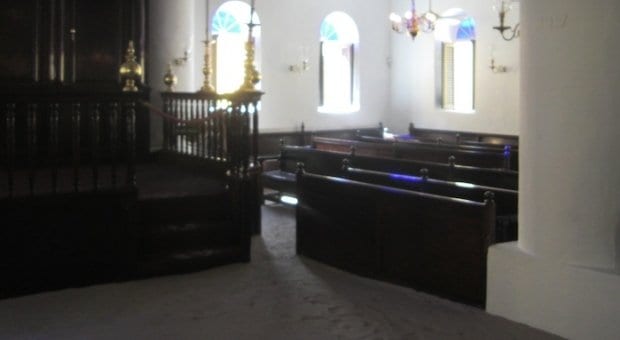
The Mikvé Israel-Emanuel Synagogue has azure-blue windows that reflect onto its unique sand floor. Credit: Danny Glenwright
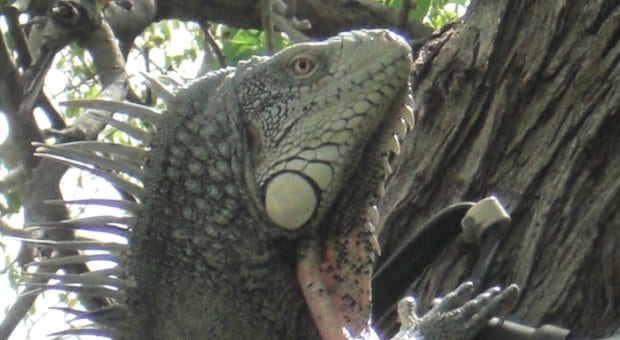
Iguanas are everywhere on Curaçao, including on some local menus. Credit: Danny Glenwright
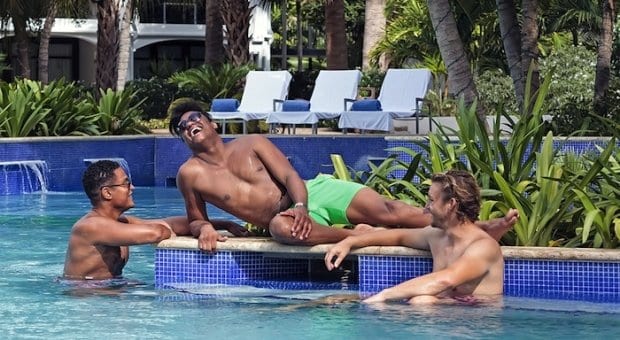
Floris Suite Hotel is Curaçao’s first adult-only gay hotel. Credit: Courtesy of Floris Suites Hotel
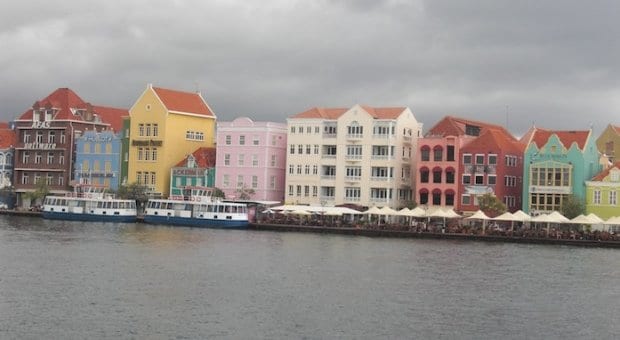
Curaçao’s oldest and most famous architectural strip is this saltwater-taffy-coloured row of buildings along Handelskade Street. Credit: Danny Glenwright
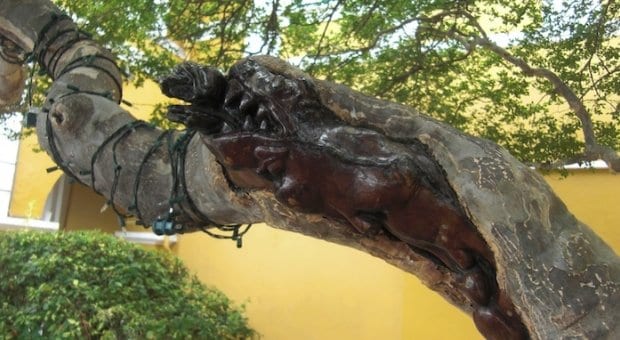
Curaçao artist Mac Alberto has whittled several human-like carvings into a row of wayaka trees outside Willemstad’s Fort Amsterdam. Credit: Danny Glenwright
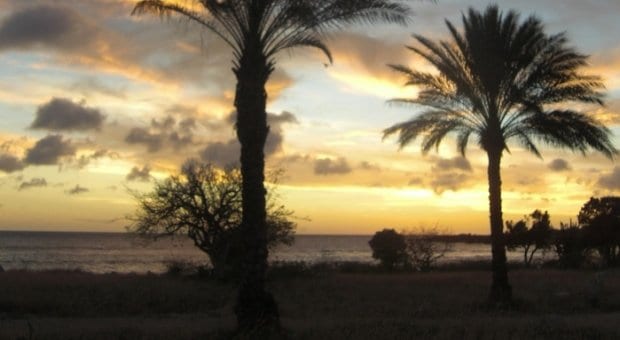
The sun sets over the luxurious Santa Barbara Beach and Golf Resort. Credit: Danny Glenwright
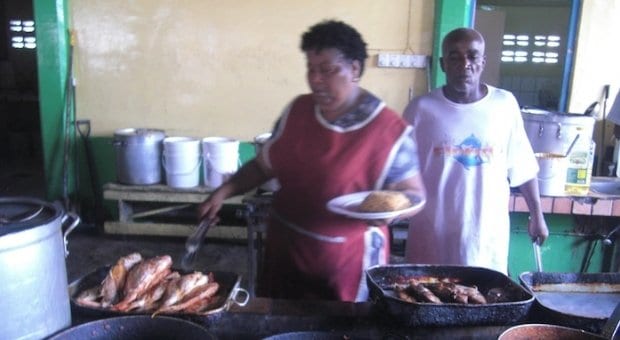
Local chefs prepare everything from fish soup to goat stew in Old Market food stalls. Credit: Danny Glenwright
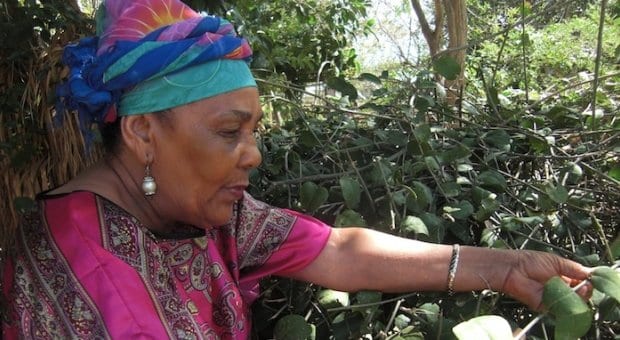
Dinah Veeris, known as the island’s plant lady, in her public herb garden. Credit: Danny Glenwright
From our archives, this article was first published in December 2014
• • •
Emlyn Peters leans against the nondescript tree and raises a hand to protect his eyes from the prodigious sunshine elbowing its way through the branches. He points upward at a human figure carved into the variegated trunk. The tree’s splotchy olive-coloured bark resembles an army-issue camouflage pattern, but the relief-like carving inside is a smooth mahogany.
Curaçao artist Mac Alberto has whittled several of these human-like forms into a row of wayaka trees outside the historic Fort Amsterdam in downtown Willemstad, the capital of this tiny Caribbean island. Peters, a local history buff, says Curaçaoans compare the wayaka to a snake because it constantly sheds its bark “so it can stay young forever.” The indigenous tree, also known as lignum vitae — Latin for “tree of life” — is in a perpetual cycle of renewal.
It is not unlike Curaçao, which, despite a dark history as one of the largest slave depots in the Caribbean, has managed to continuously reinvent itself while also respecting and preserving its patchwork past.
First “discovered” by the Spanish in 1499, the island later fell into the hands of the Dutch in the mid-17th century. For the next 200 years, the large European powers played a game of colonial badminton with Curaçao. Even a historian like Peters has to pause to get the dates right. The English conquered the island in 1800, but it soon fell to the French under Napoleon in 1803. The French held it until the English wrested back control in 1807 — but they kept the island only until 1816, when it was swatted back to the Dutch in the Treaty of Paris.
Despite this back and forth — and the island’s strong African and South American influences — Curaçao has remained proudly Dutch (it is one of four countries that make up the Kingdom of the Netherlands). This is evident in its well-preserved colonial-style Dutch architecture that combines a modernist European aesthetic with a distinct Caribbean colour scheme. While the entire historic Willemstad city centre is a UNESCO World Heritage site, its oldest and most famous architectural strip is a saltwater-taffy-coloured row of buildings along Handelskade Street, in the Punda neighbourhood. The best vantage point from which to view it is on the Queen Emma Bridge, which locals affectionately call the “Swinging Old Lady.” Built in 1888, it’s supported by 16 pontoon boats that allow the bridge to swing open and give ships access to the city’s port.
Most locals will tell you that Curaçao has maintained its Dutch architectural heritage better than its Leeward Antilles sister islands Aruba and Bonaire. But it’s been at a cost. Unlike in Holland, Caribbean construction materials are basic, mostly plaster made from coral stones and sand. It means the government pays thousands of dollars each year to preserve its historic buildings, plastering and painting over what Peters calls “wall disease” — when salt creeps into the walls, peeling off layers of paint and eating into the loose coral stone. “It’s the greatest challenge for the last 20 years; the government is spending a lot of money renovating buildings,” he says, noting that Curaçao’s well-preserved architectural landmarks, including its landhuizen, former plantation houses dotted around the island, remain a major tourist draw.
That’s another quality Peters says Curaçao has inherited from the Dutch: a progressive and adaptable government that, in stark contrast to many others in the Caribbean — not to mention other parts of the world — recognizes what needs to be done to keep this speck of coral solvent. The island is home to just 150,000 people, and it imports more than 90 percent of its food, including produce from Venezuela that locals purchase at Willemstad’s “floating market” — a fleet of boats that dock on the east side of the harbour along the Sha Caprileskade in Punda. The island also has few natural resources, yet it’s managed to maintain one of the highest standards of living in the Caribbean. This is mostly due to its knack for reinvention. Over a few hundred years, Curaçao’s economic engine has successively been powered by a variety of commercial activity, beginning with salt mining and slavery and later shifting to shipping, trading, tourism and oil (which continues to represent the lion’s share of the island’s exports, thanks to an ugly refinery built in 1920). Most recently, the Curaçao Tourist Board, with full support from the government, is attempting to reinvent the island as the Caribbean’s most gay-friendly destination.
“Dutch people have always been known for their controversial progressive mentality,” says Peters, noting that this is one reason Curaçaoans are proud of their connection to Holland. To prove his point, he’s led me through Willemstad’s narrow laneways to another Curaçao anomaly: the Mikvé Israel-Emanuel Synagogue. The bright-yellow synagogue’s congregation can be traced to 1651, when 12 Sephardic Jewish families migrated to Curaçao from Amsterdam, where they had fled following religious persecution in Spain and Portugal. The current building dates back to 1730, and its temple is the oldest in continuous use in the Americas. About 350 Jewish families still live on the island. “We are very proud because we have many things in our culture from the Jewish people,” Peters says.
In the daytime, the synagogue’s azure-stained windows cast a blue light on the rows of pews carved from wayaka wood. The tree of life is resistant to termites and doesn’t burn easily, another reason its wood is so cherished here. The synagogue’s sand floor is also distinctive; it’s one of just five remaining sand-floor synagogues in the world (four can be found in the Caribbean). The custom likely began in the 1600s in Brazil, where Jews were forbidden from operating synagogues. They used sand on prayer-room floors to muffle the sound of worshipers coming and going.
Myrna Moreno, the curator of Curaçao’s Jewish Cultural Historical Museum, tells me Jews have always been welcomed in Curaçao, so the sand floor at Mikvé Israel-Emanuel was simply a way to protect and treasure Jewish history in this part of the world. Moreno’s husband’s family was one of the first to settle in Curaçao in 1651. These early Jewish families brought many of the artifacts on display in the museum today, including a Torah scroll dating back to 1320 and a 200-year-old silver tray that is still used for the smashing of the wine glass at weddings. The museum is also home to a copy of Anne Frank’s Diary of a Young Girl that has been translated into Papiamentu, the island’s local Creole language that includes a mixture of Spanish, Portuguese, Dutch, English and French, with some African and Arawak Indian influences.
The people of Curaçao embrace this distinct historical potpourri today, but much of it was suppressed for decades, according to Dinah Veeris, a woman known as the island’s plant lady. Veeris has spent years consulting with local spiritual healers in an effort to revive the use of traditional herbal and naturopathic medicine. She first learned about the island’s indigenous plant life from her mother but forgot much of that knowledge when, like many Curaçao youth, she left to study in Holland. She eventually returned to Curaçao, and today runs a botanical garden outside Willemstad, where she cultivates more than 300 species and turns them into everything from soap to constipation remedies.
Veeris excitedly walks me through her public herb garden when I stop by (if you plan to visit, call ahead to book an English-language tour). She opened it in 1991, but it feels like she’s telling her stories for the first time. At one point she pauses in a shady spot and takes a deep breath as if she’s tired. But then she raises her head, lifts her arms into the air and bursts into song — her thunderous singing voice carrying over the entire compound. She grabs my arm and begins dancing, kicking up dust as she drags me in a circle. I smile awkwardly and attempt to shuffle my uncoordinated feet, deferent but also completely unsure of what I’m supposed to do next. She eventually stops, explains the song’s history as a harvest chant, and then quickly moves on to the next exhibit. Veeris snaps off a twig and shoves the end of it in her mouth. It’s what the islanders once used as a toothbrush, she says. A moment later she is lovingly stroking the ossified remains of a cactus, a plant that is ubiquitous on Curaçao and used in many of Veeris’s concoctions. “We also make cactus soup,” she says. “One of our national foods.” Next up is the moringa tree, whose roots were eaten by slaves in order to build strength. She pulls a seed pod from its branches, cracks it open like a pea and offers me a small black pip. “Eat it,” she says. “You’ll have energy and won’t be tired until late tonight.” I’m not sure that’s what I want, but I’m also not sure how to say no to this formidable herbalist. The seed is both astringent and sweet, a natural Red Bull.
Veeris has seen a reawakening of interest in natural remedies since she first began collecting information about herbal traditions from elders on the island. For years the Catholic Church prohibited the use of traditional medicines for healing, so much of this work was carried out in secret and passed down among certain families. “At the beginning they hardly tell anything, but you have to go back and get their confidence,” she says of about 20 elder leaders from whom she learned much of what she knows. “Nowadays it starts again; people want to go back to nature, back to green.”
She pauses as she approaches the next tree, kicks aside a large pile of iguana crap, and looks reverently into the branches. “This is a very old and potent tree,” she says as she leans against the familiar olive-coloured bark. You guessed it — the wayaka, Curaçao’s tree of life and renewal. “If people feel weak, they stand under this tree,” she says.
As I’m in no need of a lean, instead energized from the moringa seed, I thank Veeris and head back to Willemstad to check into Curaçao’s first gay hotel.
In 2011, the Argentine owners of the Floris Suite Hotel decided to take a risk. They asked Frank Holtslag, who was then managing one of their Miami properties, to move to Curaçao and turn Floris into the island’s first gay, adult-only hotel. “We decided to go very slow in the gay market,” Holtslag tells me over dinner at Sjalotte, Floris’s excellent restaurant. “Of course, we still want to make money.”
But over the last two years, Holtslag and Jurandy Regina, Floris’s sales and marketing manager, have worked incrementally to completely change the look and feel of one of the oldest hotel properties in Willemstad. Along the way they lost three staffers who were uncomfortable with the gay thing, but they’ve also gained new employees who help give the hotel a genuine gay boutique vibe. “A lot of people from the community want to be part of it,” Regina says, noting that many of the hotel’s staff and about 30 percent of its clientele are now LGBT.
While Floris is not directly on the water, it has two private beaches that are a five-minute walk from the main lobby. There gay couples kiss and hold hands openly, says Holtslag, who is also overseeing a poolside expansion that will include a new gym, spa and sauna complex.
The Floris transformation is a key element in the island’s latest makeover as a gay destination, says the Curaçao Tourist Board’s North American marketing manager Andre Rojer, who is gay. Like the divers who travel to Curaçao to jump into its clear blue water, the country’s decision makers seem to have leapt feet first into the gay market. “We don’t secretly [promote Curaçao as a gay destination]; we openly do it. It’s in every sector, in every market, even in Parliament, even the prime minister,” says Rojer.
And it appears to be working. Floris now plays host to the island’s most happening gay night, the Rainbow Lounge. The Friday-night happy-hour party is a gathering spot for local gays and tourists who often later move on to one of the island’s other gay-friendly nightspots. The hotel is also the main venue for Curaçao’s annual Pride festival, and in May 2014 it will host the first South Caribbean Pride. “The idea is to have a Pride for those islands that can’t celebrate Pride for political reasons,” Holtslag says, noting this includes Trinidad, Tobago and Jamaica. “We’re the most tolerant island in the Caribbean.”
Arcusio Arruda Massa agrees. He’s a local journalist I meet at Floris’s Rainbow Lounge party. He tells me about Pink House, the island’s LGBT multipurpose centre, and says Curaçao has always been gay-friendly — he came out at a young age and says he’s rarely encountered homophobia. “We are ready for everything,” he says when I ask about the tourist board’s push to turn the island pink.
I think he’s right. While Curaçao will never have the population to sustain large gay bars and clubs, it has all the other credentials necessary to become the beloved gay destination its proponents have been pitching it as — not to mention glorious beaches, heaps of natural beauty and compelling historical sites. Perhaps most auspiciously, Curaçao’s gay hotel is home to a healthy stand of wayaka trees, surely a sign that some of the island’s most ancient residents endorse its latest experiment in revitalization.
Where to eat
Go to Willemstad’s Old Market (Plasa Bieu) for a taste of local culture and cuisine. Several chefs specialize in a variety of dishes at individual food stalls. You can try everything from cactus soup to goat stew and fried plantains. For dessert, there’s pumpkin cake. The market is open Monday to Saturday from 11:30am to 3pm. A safe bet is Ivonne’s food stall, where we tried a very tasty fish soup.
Another Curaçao landmark is Jaanchies, in scenic Westpunt, the westernmost point of the island. The busy restaurant has been going strong for more than 60 years, likely because it’s one of the few spots where tourists can sample iguana. Best to try a side dish of the island’s most common — and very boney — lizard (with Jaanchies’ lovely tomato sauce) and order one of the delicious seafood dishes as a main.
Where to stay
The Santa Barbara Beach and Golf Resort is a large and lavish spot about 15 minutes outside Willemstad. If you’re looking for a quiet and relaxing beachside hotel, this is your best bet. You’ll need to rent a car if you want to explore beyond the Santa Barbara complex, although the resort has plenty on offer to keep guests busy, including a luxury spa, sunset boat tours, snorkelling and scuba diving, yoga, tennis, biking, meditation, golf, fishing, iguana feeding, bird walks and plenty of poolside lounging opportunities. Santa Barbara has a selection of excellent dining options, as well as a tasty gelato bar that is not to be missed.
For those who want to be in the city and prefer self-catering, Floris Suite Hotel’s 72 rooms each have fully equipped kitchens and dining areas. Another option is the Beach House Hotel complex. It’s actually not a hotel, but rather 24 self-catering apartments near Sea Aquarium Beach in Willemstad. The complex has a swimming pool and a full restaurant.
Getting there
In season, Westjet runs weekly nonstop flights from Toronto’s Pearson Airport to Curaçao. There are also several daily flights between Miami and Curaçao.
Getting around
Curaçao is small, safe and easy to navigate by car. While you might not want a vehicle for your entire stay, rent one for a couple days so you can check out some of the sights outside Willemstad, such as Deena Veeris’s botanical garden or the Curaçao liqueur distillery. And no sensible tourist should travel to Curaçao without exploring the western side of the island, especially the island’s magnificent white-sand beaches, including Big Knip, which was featured on an episode of The Bachelorette.
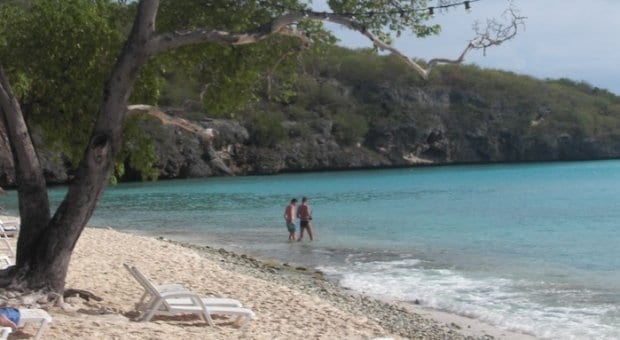
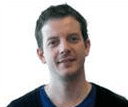
 Why you can trust Xtra
Why you can trust Xtra